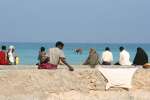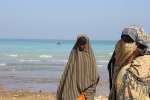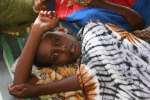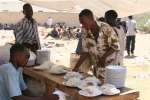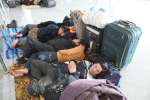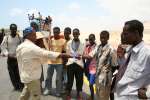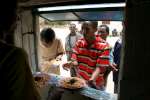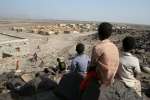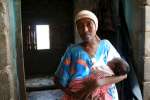Regional Conference on Refugee Protection and International Migration in the Americas: Protection Considerations in the Context of Mixed Migration (San José, Costa Rica, 19-20 November 2009)
Migration, 20 November 2009
The Regional Conference on Refugee Protection and International Migration in the Americas was hosted by the government of Costa Rica and took place on 19-20 November 2009 in San José. Its main aim was to enhance the response to mixed movements in the Americas in a protection-sensitive manner, both on the national level as well as through enhanced utilization of existing regional migration processes and human rights mechanisms.
The conference brought together more than 200 representatives from 20 states, academia and civil society. In plenary sessions and working groups, participants identified the main protection challenges, exchanged information and experiences and discussed the protection needs of, amongst others, refugees, trafficked persons, unaccompanied/separated children and victims of physical/sexual violence or trauma, as well as the human rights of people on the move.
The conference was funded by the European Commission and the US State Department's Bureau for Population, Refugees and Migration. It was co-organized by the UN High Commissioner for Refugees, the International Organization for Migration and the Organization of American States, in cooperation with the Office of the High Commissioner for Human Rights.
1. Main Conference Documents
- 1.1 Agenda [English] [Spanish]
- 1.2 Concept Note [English] [Spanish]
- 1.3 Background Paper: Refugee Protection and International Migration in the Americas: Trends, Protection Challenges and Responses
- 1.4 Keynote speech by Ms. Erika Feller, Assistant High Commissioner – Protection
- 1.5 Conference Report [English] [Spanish]
- 1.6 Summary of Recommendations [English] [Spanish]
- 1.7 List of Participants [English/Spanish]
- 1.8 Biographies [English] [Spanish]
2. UNHCR 10-Point Plan on Mixed Migration and Refugee Protection
- 2.1 UNHCR: Refugee Protection and Mixed Migration: A 10-Point Plan of Action [English] [Spanish]
- 2.2 UNHCR's 10-Point Plan in Central America, Western Africa, Eastern Africa and Southern Asia – a three year project [English] [Spanish]
3. Background Information on Mixed Migration
3.1 Extra-Regional and Stranded Migrants
- 3.1.1 Regional Conference on Migration: General Framework for Execution of the Multilateral Cooperation Progam for the Assisted Return of Extra-Regional Migrants Stranded within the Member Countries of the Regional Conference on Migration (RCM), or Puebla Process [English] [Spanish]
3.2 Human Rights and People on the Move
- 3.2.1 Global Migration Group: International Migration and Human Rights – Challenges and Opportunities on the Threshold of the 60th Anniversary of the Universal Declaration of Human Rights [English]
- 3.2.2 IOM: Elusive Protection, Uncertain Lands – Migrants access to human rights (2003) [English]
- 3.2.3 IOM: International Dialogue on Migration, Human Rights and Migration: Working Together for Safe, Dignified and Secure Migration – Effective Approaches for Policy Makers (2009) [English] [Spanish]
- 3.2.4 IOM: Working to Prevent and Address Violence Against Women Migrant Workers (2009) [English]
- 3.2.5 IOM: Protection of Persons Involved in Migration – Note on IOM's Role (2007) [English] [Spanish]
- 3.2.6 OHCHR: Migration and Development – A Human Rights Approach (2008) [English]
- 3.2.7 OHCHR: Recommended Principles and Guidelines (2002) [English] [Spanish]
3.3 Identifying and providing International Protection
- 3.3.1 UNHCR High Commissioner's Dialogue on Protection Challenges – Refugee Protection, Durable Solutions and International Migration (2007) [English] [Spanish]
- 3.3.2 Global Consultation on International Protection: Refugee Protection and Migration Control – Perspectives from UNHCR and IOM (2001) [English] [Spanish]
- 3.3.3 Extracts of the Agenda for Protection [English] [Spanish]
3.4 Migration Management
- 3.4.1 IOM: The International Standards on Human Rights and Migration Policies (2007) [Spanish]
- 3.4.2 Guide on Ratification – International Convention on the Protection of the Rights of All Migrant Workers and Members of their Families (2009) [English]
- 3.4.3 International Federation of Red Cross and Red Crescent Societies (IFRC) Policy on Migration (2009) [English]
- 3.4.4 IOM: Border Management and the Role of IOM (2009) [English]
- 3.4.5 OHCHR Expulsion of Aliens in International Human Rights Law (2006) [English]
- 3.4.6 UNHCR: Application of Article 1A(2) of the 1951 Convention and/or 1967 Protocol relating to the Status of Refugees to victims of trafficking and persons at risk of being trafficked [English] [Spanish]
- 3.4.7 United Nations Office on Drugs and Crime (UNODC): Model Law against Trafficking in Persons (2009) [English]
3.5 Profiling and Referral Mechanisms
- 3.5.1 UNHCR: Identification and Referral of Trafficked Persons to Procedures for Determining International Protection Needs [English] [Spanish]
3.6 Smuggled and Irregular Migrants
- 3.6.1 IOM: International Dialogue on Migration, Challenges of Irregular Migration – Addressing Mixed Migration Flows (2008) [English] [Spanish]
- 3.6.2 IOM: Irregular Migration and Mixed Flows – IOM's Approach (2009) [English] [Spanish]
3.7 Unaccompanied Children
- 3.7.1 UNICEF: Migration and Children (2006) [English] [Spanish]
- 3.7.2 Committee on the Rights of the Child – Observation General No. 6, Treatment of Unaccompanied and Separated Children Outside their Country of Origin (2005) [English] [Spanish]
3.8 Victims of Human Trafficking
- 3.8.1 IOM: The International Meeting on Implementation of Justice, Trafficking in Persons: Exchange of Experiences [Spanish]
- 3.8.2 IOM: Psychosocial Intervention Guide for direct assistance to trafficked persons (2007) [Spanish]
- 3.8.3 UNHCR: Considerations on the Issue of Human Trafficking from the Perspective of International Refugee Law and UNHCR's Mandate (2009) [English] [Spanish]
- 3.8.4 UNODC: Global Report on Trafficking in Persons (2009) [English] [Spanish]
4. Mixed Migration in the Americas
- 4.1 Economic Commission for Latin America and Caribbean (ECLAC): International Migration, Human Rights and Development in Latin America and the Caribbean (2006) [English] [Spanish]
- 4.2 Inter-American Court of Human Rights, Advisory Opinion OC-16/99, 'The Right to Information on Consular Assistance in the Framework of the Guarantees of the due Process of Law' (1999) [English] [Spanish]
- 4.3 Inter-American Court of Human Rights, Advisory Opinion OC-18/03, 2003, Juridical Condition and Rights of the Undocumented Migrants (2003) [English] [Spanish]
- 4.4 IOM, Trafficking in Persons and Smuggling of Migrants: Treatment and Analysis of the National Laws of the South American countries (2007) [Spanish]
- 4.5 ECOSUR-REMISUR, The Dynamics of Migration Flows on the Southern Border of Mexico: a Brief Interpretation (2008) [Spanish]
- 4.6 IOM, Regional Study on the norms regarding human trafficking in Central America and the Dominican Republic and its application (2008) [English] [Spanish]
- 4.7 IOM, State of Migration Management Central America: An Applied Research (2002) [English] [Spanish]
- 4.8 IOM, Binational study (Nicaragua – Costa Rica) on the incident migration on women: A reading from the perspective of women (2008) [Spanish]
- 4.9 IOM, Experiences of women victims of trafficking in Central America and the Dominican Republic and Related Institutional Action (2008) [English] [Spanish]
- 4.10 Human Rights Internet, Intra-Caribbean Migration and the Conflict Nexus (2006) [English and Spanish]
- 4.11 IOM, Migration Profile of the Americas (2008) [English] [Spanish]
- 4.12 IOM, The State of Migration Management in Central America: An Applied Research (2002) [English]
- 4.13 UNHCR, Declaration: Migration, Human Rights and International Protection of Refugees (2008) [Spanish]
5. Regional Migration Policy
- 5.1 South American Conference on Migration – Minutes of the Comission "Freedom of Movement of Persons" (2001) [Spanish]
- 5.2 South American Conference on Migration – Declaration of Quito (2009) [Spanish]
- 5.3 South American Conference on Migration – Report on Status of ratification of international instruments for the protection of human rights of migrants in South American countries (2007) [Spanish]
- 5.4 Regional Conference on Migration – Regional Guidelines for the Assistance to Unaccompanied Children in Cases of Repatriation (2009) [English] [Spanish]
- 5.5 South American Conference on Migration – Montevideo Declaration on Migration, Development and Human Rights of Migrants (2008) [English] [Spanish]
- 5.6 Regional Conference on Migration – Draft Plan of Action (2009) [English] [Spanish]
- 5.7 Regional Conference on Migration – General Framework for Execution of the Multilateral Cooperation Program for the Assisted Return of Extra-Regional Migrants Stranded within Member Countries of the Regional Conference on Migration (RCM), or Puebla Process [English] [Spanish]
- 5.8 Regional Conference on Migration – Guatemala (2009) Final Declaration [English] [Spanish]
- 5.9 Regional Conference on Migration – Guidelines for the Signing of Multi and/or Bilateral Agreements Between Member Countries of the Regional Conference on Migration (RCM) Regarding The Repatriation of Regional Migrants by Land (2004) [English] [Spanish]
- 5.10 Regional Conference on Migration – Regional Guidelines for Special Protection in Cases of the Repatriation of Child Victims of Trafficking (2007) [English] [Spanish]
6. Conference Poster
- Download the regional conference posters (pdf) and banner (zipped file) here
7. Visit UNHCR's Spanish website for conference information in Spanish.





